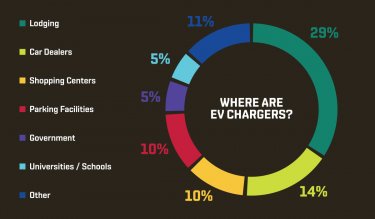Numbering 150,000 nationwide, gas stations are one of the most common fixtures on American roads—ten times more common than McDonald’s, and even outnumbering K-12 schools in the country, which is why it might come as a surprise that they may soon all be gone. With electric vehicle sales soaring globally and policymakers scrambling to wean the world from its fossil fuel diet, the utility of gas stations—which are expensive to build and dangerous to operate—is fast diminishing. In October Uber announced it would purchase 50,000 Teslas by 2023 as a part of the company’s goal of being 100 percent electric in the US and Canada by 2030. More recently, rental car company Hertz announced it will purchase 100,000 Tesla model 3 EVs by the end of 2022 in an effort to cut its emissions. This deal also includes “…new EV charging infrastructure across the company’s global operations.” It seems that like public telephones, gas stations could go from valued social utility to a relic in little more than a decade.
In their place will emerge mixed-use charging stations that integrate vehicle charging into the way we move through everyday life. Drivers will be able to charge while shopping, sleeping or working—and eventually without even stopping at all.
The consequences: a changing American driving landscape, and a fundamental shift in how drivers decide when, where and how to make stops. This decision, made millions of times a day, will create large ripples for both consumers and brick and mortar businesses.
Let’s take a look at the immediate and distant future of charging to identify the forces of change that will usher in the next era of transportation and travel.
In fact, not only does putting EV charging stations next to commercial centers tend to draw customers, it keeps them there longer. One study found that in department stores where charging stations were available, EV drivers spent 20 percent longer shopping than traditional drivers—a concept that John Eichberger, executive director for the Fuels Institute, referred to as “getting your money’s worth.”
By removing dead wait time, and with the ability to safely install charging stations in locations from schools to malls, it’s likely that vehicle charging will shift from an independent experience to a complementary experience, making gas stations, whose sole utility is quick fuel, obsolete.
While eliminating charging stops is ostensibly a benefit to such electrified infrastructures, the true benefit could be eliminating car ownership altogether.
As companies like Uber continue to forge the path toward autonomous driving, charging remains a large impediment. By having cities with constant accessible current beneath their streets, Uber and other delivery and ride share companies could theoretically own or lease fleets of vehicles that remain perpetually in motion—never needing to park or charge.
Without barriers to service, autonomous electrified driving costs could come down and be so reliable that it would no longer make sense for people to pay $9,000 a year to own a vehicle. Instead we’ll opt to schedule robo-rides wherever we need to go.
By combining electrified roads, regular roads and solar power, electric vehicles will see a patchwork of continual charge and self-charge that will make transport possible to virtually any location without stopping. As gas stations give way to mixed-use charging stations (and eventually no stops altogether) the structure of roads and highway exits will likely follow until ultimately self-driving cars and trucks are perpetually orbiting the nation, picking up and dropping off riders and freight, and some charge along the way.


